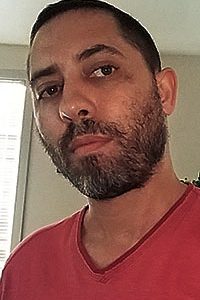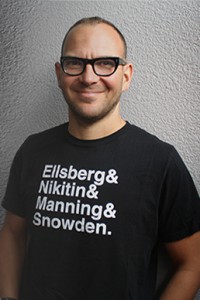Kim Stanley Robinson: Forward the Future

Kim Stanley Robinson was born March 23, 1952 in Waukegan IL, and grew up in Orange County CA. He earned a BA in literature from UC San Diego in 1974, a master’s in English from Boston University in 1975, and a Ph.D in literature from UC San Diego in 1982. He went to Clarion in 1975. His doctoral thesis was revised and published as The Novels of Philip K. Dick (1984). He lived in Switzerland and Washington DC in the ’80s, and has spent time doing research in Nepal, Antarctica, Italy, and China, among other locations.
Robinson’s first stories appeared in Orbit 18 (1976). Many of his short stories are collected in The Planet on the Table (1986) and Remaking History (1991). Retrospective collection The Best of Kim Stanley Robinson appeared in 2010. Important short works include World Fantasy Award winner “Black Air” (1983) and Nebula Award winner “The Blind Geometer” (1986). He edited Future Primitive: The New Ecotopias (1997), and In the Sierra: Mountain Writings by Kenneth Rexroth (2012), and he is part of the “Mount Thoreau Collective” along with Paul Park, Michael Blumlein, Carter Scholz, and others, which published Naming Mt. Thoreau, edited by Laurie Glover, in 2017.
His first novel, The Wild Shore (1984), began his Three Californias trilogy, collected into one volume by Tor in 2020. The Gold Coast (1988) and Pacific Edge (1990) followed, with the latter winning the John W. Campbell Memorial Award. Other early novels include Icehenge (1984) and The Memory of Whiteness (1985). Fantasy works include mosaic novel Escape from Kathmandu (1989) and surreal fantasy novella A Short Sharp Shock (1990), winner of a Locus Award.
Robinson made his name with the groundbreaking Mars trilogy: Nebula Award winner Red Mars (1992), and Hugo and Locus Award winners Green Mars (1993) and Blue Mars (1996). A collection of related material, The Martians (1999), also won the Locus Award. Near-future ecological thriller Antarctica was the result of a National Science Foundation grant that sent Robinson to Antarctica as writer-in-residence. Locus Award winner The Years of Rice and Salt (2002) is a major alternate history about the development of science.
His Science in the Capital trilogy explored global climate change and ecological disasters: Forty Signs of Rain (2004), Fifty Degrees Below (2005), and Sixty Days and Counting (2007); a version updated and abridged as single novel was published as Green Earth (2015). Campbell Memorial and Arthur C. Clarke Award finalist Galileo’s Dream (2009) combined historical fiction and far-future SF, while Nebula Award winner 2312 (2012) explored the solar system 300 years hence, and Shaman (2013) is set in the Paleolithic era. Campbell Memorial Award finalist Aurora (2015) is about a generation starship, and Hugo and Campbell Award finalist New York 2140 (2017) explores the city transformed by sea level rise. Red Moon (2018) is about a Chinese lunar colony. His latest novel, The Ministry for the Future (2020), concerns the consequences of climate change.
Robinson lives in Davis CA with his wife of almost 40 years, environmental chemist Lisa Nowell; they have two sons.
Excerpts from the interview:
“When we’re at my wife’s family place in Maine, I don’t have enough time to do all the things I want to do. It’s like Calvin and Hobbes – ‘The days are just packed.’ When I’m here in Davis, it’s the opposite. There’s nothing to do but write. This explains a lot about me. I have my daily gardening and running frisbee golf with a friend, and my walk with Lisa, and beyond that, it’s writing. That’s not so terrible, since I like to write. But wow, in this first week back from Maine, it’s kind of shocking. Hopefully we’ll spend more of every year in Maine, in the years to come. These days I’d rather build my sentences with rocks.
“One Zoom event I’ll get to here is the Antarctic Artists and Writers’ alumni group, which has finally been formed, and right when it’s needed, since the Trump administration killed the program last year. Now that there’s an alumni group, we have a way to fight to get the program reinserted into the NSF budget next year. That would be good. There are about 120 of us now, and they’ve done great work.
“Most of what I wrote about in The Ministry for the Future is already out there in the world. I did very little extrapolating of technology. The book’s plan for slowing down Antarctic glaciers is the idea of an individual glaciologist who shared it with me, telling me he didn’t want to talk in public about it because he didn’t want to get dragged into the geoengineering wars. After doing an event with Michael Mann, I had to agree that once you get tagged as a leading climate scientist, your whole career is torched from then on by enormous political firefights. For geoengineering, it’s even worse, so if what you really love is glaciology, you need to stay out of that. This guy told me, ‘You spread the idea. That’s what science fiction is for.’ So I asked other glaciologist friends what they thought of it, and they said, ‘Can’t be sure, would be hard to know where to pump the water up, the glaciers would need to be the kind that are bedded in canyons, not just flowing down a big tilted slope, so you’d have to get lucky, but maybe it could work in some places,’ and so on – they went on like that in the usual scientist way, and I thought, ‘Heck it sounds good enough, I’m going to run with it.’ It seems plausible enough to be worth bringing up. I like the sea level where it is.
“The other important part of my plot, the carbon coin, comes out of a paper I ran into online, by Delton Chen. It sounded plausible to me, so I asked some economist friends about it, and they said, ‘Yeah, this is an idea being discussed.’ It’s a kind of quantitative easing, which we’ve certainly seen a lot of recently, only this time it involves newly created money that gets paid specifically for carbon sequestration. The idea has gone from fringe to mainstream quite quickly, as people realize we need some Keynesian or postcapitalist political economy to pay ourselves to decarbonize and otherwise mitigate climate change, to hopefully dodge a mass extinction event. It was clear to me that this financial plan was an important element for any story describing a best-case outcome. Even the president of the World Bank recently said, ‘We need to put a price on carbon.’ It was shocking to hear the World Bank say that, because it’s been awful throughout its history, an instrument for extracting value from the developing world. It’s backed fossil fuels, gigantic dams, cash crops instead of local food production, and so on. It’s added to climate change, and is among the institutions that need reform, from inside or out. With this statement we see a crack in the wall. Pretty soon after that, the Paris Agreement was signed, and that was huge. A major event in world history. All this turmoil in economic theory for coping with climate change seemed to me like it was right on the cusp of being a coherent story, a future history that could be told without being too implausible. It felt sort of like the Mars terraforming discussions in the late ’80s. A whole body of ideas had been coalescing for a while, and a big new story was there waiting to be told. The same is true now for climate change-driven postcapitalism.
“My novel is a patchwork, in a ‘form follows function’ way, because history is a patchwork. I wanted a global story, and this was the method that let me do it. Lots of different modes came in useful. I have my smooth interviewer and his grumpy guest, based on the WWII BBC tapes of George Orwell and William Empson, with Orwell unflappable in the face of Empson’s rudeness. That struck me funny, and in general I was looking for funny. Climate change and existential survival, the likely grotesque nature of the next 30 years – it’s not obviously funny. It’s not even narratizable, really, but I’m under a compulsion, it seems, so I’ve had to think about art as entertainment versus art as education. Aristotle and Brecht are both clear on this as a false distinction, that education can be entertaining, and entertainment educational. You want both. But it’s easier said than done, and this novel deals with particularly grim stuff. Heat waves killing millions, PTSD both individual and social – the pleasure to be had in reading about such stuff was a little elusive to me. So when I came to the form of many voices and styles, I saw that the variation itself could be pleasing for some readers. There are 106 chapters, but when you start a chapter you don’t know what kind of thing it’s going to be. It might be a riddle, might be an ordinary dramatized scene, might be an interview or a transcript, or meeting notes, or an eyewitness account. Patterns could emerge from that, or at least a certain rhythm, and a game to play.
“The eyewitness accounts were the crucial discovery for me. Eyewitness accounts are a genre of their own. I had not comprehended that until I began to read collections of them. What people saw in the spring of 1945 in Germany, or during Napoleon’s Waterloo campaign, or May 1968 in France, or in the current refugee crisis, and so on. I read about a dozen of these collections and began to understand that in this genre, you don’t dramatize scenes, not like a novel does. You cut to the chase – in effect, you don’t show, you tell. And that I loved. I hate all workshop prescriptions for how fiction is supposed to work. Do this, do that – give me a break. We don’t know how fiction works, so I don’t believe in writing workshops, which is of course hilarious because I’m so involved with Clarion, and I’m a child of the workshop system myself. I’ve sorted out that confusion by realizing that the workshops themselves are fine – they’re like getting published for the first time, to a small audience that actually gives you helpful feedback, so all that is fine. It’s just all the generalizations about writing that have emerged from that system, the various MFA truisms and the bullshit lexicons, and even the standard craft terminology, it’s all stupidly simplistic. So you have to go into workshops distrusting every generalization, because there aren’t any rules, and anything might work. After One Hundred Years of Solitude by Gabriel Garcia Marquez, ‘show don’t tell’ in particular is shattered, because that novel is 350 pages of telling, with no showing whatsoever, and it’s one of the greatest novels ever written. Ponder that before you write yet another story made up of seven dramatized scenes in a row. It’s time for some telling. You’re not a mime.”
Interview design by Stephen H. Segal. Photo by Arley Sorg.
Read the full interview in the December 2020 issue of Locus.
 While you are here, please take a moment to support Locus with a one-time or recurring donation. We rely on reader donations to keep the magazine and site going, and would like to keep the site paywall free, but WE NEED YOUR FINANCIAL SUPPORT to continue quality coverage of the science fiction and fantasy field.
While you are here, please take a moment to support Locus with a one-time or recurring donation. We rely on reader donations to keep the magazine and site going, and would like to keep the site paywall free, but WE NEED YOUR FINANCIAL SUPPORT to continue quality coverage of the science fiction and fantasy field.
©Locus Magazine. Copyrighted material may not be republished without permission of LSFF.








